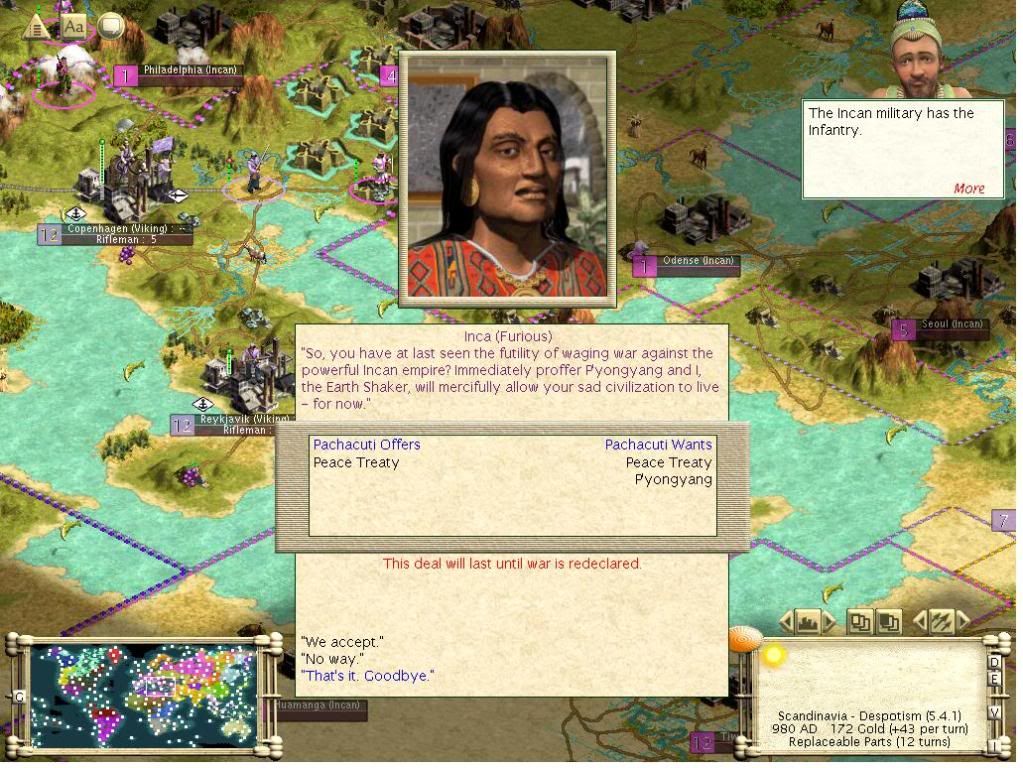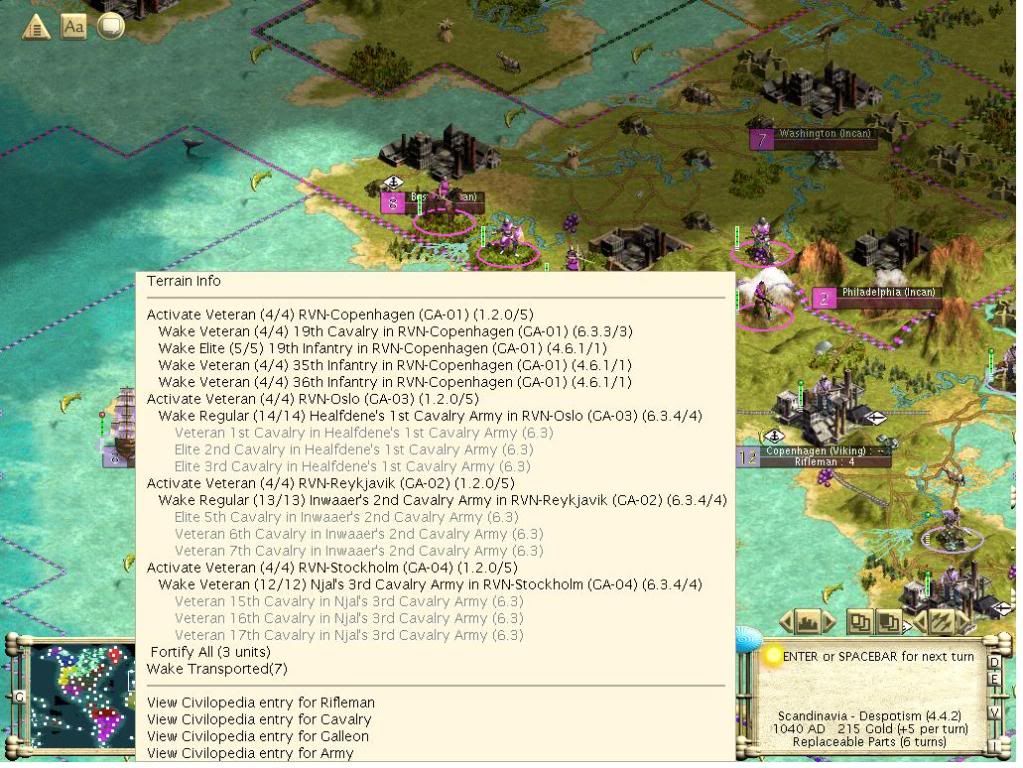POST 1000!!! I was saving this, so here it is.
The skill of the Viking diplomats always brought hope into Ragnars heart. But he never thought they were this good.
You were able to do WHAT!?!
As I told you, we were able to make peace with the Inca. Their ruler, Sapa-Inca Pachacuti was also tired of war. He was willing to end the war, with one minor hitch. We had to hand over all ownership of the Mesopotamian province, and its capital, Pyongyang.
A price I am willing to pay for peace. said Ragnar. Thank you for this.
You are welcome, Lord.
As the diplomats leave the royal chamber, Ragnar lets out a sigh of relief. Finally, he thought, peace. Now I can worry about other matters, such as the decaying relations with the Dutch. William will not be happy to see me. However, today will be a great day of celebration throughout the Western Viking Empire. The East has fallen, taken by the barbarians who betrayed us. But now, they aid us as friends. Thus, that day, November 5, 982 A.D. was the remembrance of the Peace of Pyongyang. Another significant event occurred on November 5th, some two hundred years ago. In Britain, an anti-Anglican rebel attempted to blow the British Parliament building to the heavens. However, this radical Catholic was thwarted by the government. His name was Guy Fawkes. From that day forth, an effigy of the traitor was burnt on November 5th. The British immigrants to the Western Viking Empire continued this tradition. Ragnar, being the devout Protestant he was, saw these burnings and made the day a national holiday for both occurrences.

In the year 1006, the German 23rd and 29th Armored Cavalry and the 17th Cavalry disembarked from the CBS-Barbarossa, the German navys second caravel. They quickly looted the fishing village of Jelling, which was West, Southwest of the Capital. Ragnar wondered what the occurrence was, and his military advisor quickly reminded him that the Western Viking Empire was still at war with the Central Afrikan Kaiserreich. Reminded of the war, he immediately decided to send a large portion of his military force to meet them. On October 14, 1013, the battle of Uppsala was in full charge.
The report of Hans Christian Ørsted, great Viking scientist, as from his house in Uppsala.
As I went down the staircase for my early morning tea on that dreary, Saturday morning, I heard the greatest commotion. Rushing to the window, I saw the Grand Liberation Army approaching. 2800 cavalrymen were riding through the city, with their polished muskets and their well-groomed horses. In the front of all them were the commanders. First was Captain Gustav Adolf, upon his chesnut-haired horse Man o War. To his left was Major Georg von Döbeln, upon his black horse Copenhagen. Then followed Colonel Canute Magnus, and his grand horse Bucephalus. Finally was General of the Army Healfdene, and his shining white horse Shadowfax. As they arrived in the city, General Healfdene started giving commands. As they had no Artillery, and the only Infantry spared was local militia, he commanded some of his troops to dismount, and dig trenches, in which they would stay. By 10:00 in the morning, German troops were in sight.
Hurry! shouted the General. Soon, the men were in the trenches, ready for the attack.
The attack started at 13:00. The first Viking strike was on the 29th Armored Cavalry. Muskets at the ready, and sabers raised, the Viking force charged. Rough fighting ensued. I was able to see the fight myself from my house. The first charge proved successful. In the end, the whole 29th Armored Cavalry was destroyed, and only 200 Viking troops were killed.
The next attack came on the 23rd Armored Cavalry. The Viking forces had almost the same luck. The whole German force was killed. However, a small group snuck around to the back. When Healfdene returned, he found a horrible sight. All his rear defense were killed in the trenches. After all the combat in the second wave, 1000 Vikings died.
As the Viking forces encamped for the night, they knew the worst was to come. They could still see the 17th Cavalry division, who was also setting up for camp. Healfdene fell asleep knowing his forces were successful.
Sir, the German 17th Cavalry is approaching!
Captain Gustav Adolf said as he entered Healfdenes tent. They have surprised us at night! Luckily, some of their cavalry fell into the traps we set in the field.
Hurried, Healfdene grabbed his saber and ran outside. All around him was fighting and shouting. From my house, I was able to see the General. He looked disoriented. Suddenly, he collapsed to one knee. One of the German cavalry had shot him in the knee. Quickly, he drew his pistol and killed the rider as he advanced. Soon, the fighting had died down. When the smoke cleared, all the German Cavalry had been defeated, with 400 Viking losses. Overall casualties: 2400 German Armored Cavalry and Cavalry destroyed, which was the whole force; 1600 Viking forces killed.
After the Battle of Uppsala, the Inca saw that the Vikings could possibly be trusted. They decided to sign a Trade Embargo with the Vikings against the Dutch.
In the year 1045, a large military operation was sent out: Task Force Gamma. Included in the Force was Healfdenes 1st Cavalry Army, Inwaaers 2nd Cavalry Army, Njals 3rd Cavalry Army, the 19th, 35th, 36th Infantry, and the 19th Cavalry. Military Historians have wondered about the relation of the Battle of Uppsala to the creation of the task force. Many think that Healfdene was sent not only to defeat the Germans, but also to assure his skill as a General. The overall number of troops was 11,200 men.
In 1065, the forces landed at their location: Southern Holland. At this time, William was already mad at Ragnar, so he thought it would work. As the forces unloaded, they pitched camp on the beaches. Seeing this as an act of war, William declared war on the Vikings. Once war was declared, the Inca saw that the Vikings were strong, and decided to sign a Mutual Protection Pact with the Vikings.
1072 was the year of the siege of Haarlem. The Grand Army of the Empire, codenamed Task Force Gamma, had 11,200 Men: Healfdenes 1st Cavalry Army, Inwaaers 2nd Cavalry Army, Njals 3rd Cavalry Army, the 19th, 35th, 36th Infantry, and the 19th Cavalry. The Dutch City Guard consisted of 3,200 men: 3 Swiss Mercenary Guards, and 3 Conscript Rifleman. The military record of the battle itself was lost, but the number of men was remembered: 2200 Viking forces from the Armies died, and the whole Dutch force was destroyed. The city had fallen and the Vikings won.
In 1077, the 4th Royal Army was produced in the Capital. Its General would be Sven Forkbeard, and he would control a elite squad of Berserks.
In 1095, the Indians landed troops on the coast of Iberia. Their units, a Medieval Infantry Division and a War Elephant, were no match for the 19th Infantry division garrisoned in the city.
With this victory, the military now has the ability to replace parts. Then, communism is rooted.
In 1102, the Siege of Howlerd occurred. The main force was Inwaaers 2nd Cavalry Army. His forces lost 1000 troops, while the Dutch defenders lost 26,000 men. Howlerd fell, along with the Dutch Isles.
A few years later, a new force was produced: the Guerilla. It was a versatile unit which had great offensive and defensive capabilities. More of these units would be produced over time.
Sven Forkbeards first main battle was the Naval invasion of Middelburg. Svens army lost 800 of its 2400 men, but killed all 1200 Dutch defenders. The city fell.
In 1120, William requested peace. Ragnar accepted. The terms were Communism and Industrialization given to the Vikings, and Electricity to the Dutch.















 , which is worth reading. (hint, hint)
, which is worth reading. (hint, hint)







